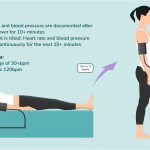ECG monitors, sometimes called EKGs, record your heart’s rhythm and rate. Keeping one at home can be useful — but which model is right for you? Below are our recommendations to help you begin.
A quick look at the best ECG monitors for home use
- Best compact ECG monitor:EMAY Portable ECG Monitor | Skip to review
- Best wireless ECG monitor:Omron Complete Wireless Upper Arm Blood Pressure Monitor + EKG | Skip to review
- Cheapest medical-grade ECG:Eko DUO ECG + Digital Stethoscope | Skip to review
- Best portable medical-grade ECG:Biocare 12-Lead ECG Machine | Skip to review
- Smallest ECG monitor:KardiaMobile 6L EKG | Skip to review
- Best wearable ECG monitor:Wellue Portable EKG Monitor | Skip to review
ECG (electrocardiogram) monitors capture and log your heart’s rhythm and rate, presenting the results as waveform tracings. A variety of ECG devices are made for at-home use.
Below, we review seven devices from trusted manufacturers and explain what you should know about consumer ECGs.
How we chose the best ECG monitors
You don’t have to buy a high-priced ECG unit for home monitoring. Numerous dependable ECG devices are clinically validated.
We evaluated these ECG monitors according to:
- accuracy
- ease of operation
- price
- power source
- battery longevity
- and several other considerations
Certain devices are designed for particular uses — for example, some are meant to be worn or easily carried. Many models also include connectivity so you can view results on a smartphone or send them to a clinician. Every device we looked at offers at least some recording capability.

Pricing guide
We show price roughly as follows:
- $ = under $100
- $$ = $100–$200
- $$$ = over $200
Healthline’s picks for the best ECG devices
Comparing options
Name | Price | Best for | Battery life | Features
EMAY Portable ECG Monitor | $ | compatibility with all smartphones | 500 readings | wide range of compatibility
Omron Complete Wireless
Upper Arm Blood Pressure Monitor + EKG | $$ | recording blood pressure and cardiac data | uses 4 AA batteries, so it depends on usage | checks ECG and blood pressure
Eko DUO + EKG Stethoscope | $$$ | detecting arrhythmias and heart murmurs | 10 hours | ECG plus stethoscope
Biocare 12-Lead ECG Machine | $$$ | providing highly detailed 12-lead ECG readings | 2–3 hours | medical-grade and portable, can be charged or plugged in
KardiaMobile 6L EKG | $ | providing detailed data on a small device | 200 hours | compact, 6-lead reading
Wellue Portable EKG Monitor | $ | continual readings | 2–3 hours | wearable and discreet
Clinical vs. consumer ECG devices
Hospital-grade ECG systems use multiple leads, wires, and electrodes. A clinician places electrodes on various body sites to obtain a full view of heart activity.
Consumer or home ECG units generally incorporate sensors into the device. You often press a finger or two to the sensors or wear a patch or band on your wrist or torso. These sensors function like electrodes, detecting and recording the heart’s electrical signals.
Some home ECGs include a screen so you can view rhythm tracings on the device itself. Others connect to an app or computer for recording, viewing, storing, and sharing ECGs.
Are personal-use ECG monitors accurate?
Personal ECGs typically provide a reasonably close estimate of heart rate and rhythm. Many consumer units use one or two leads, while clinical systems commonly use 12 leads, making them more sensitive.
As a result, home ECGs detect the heart’s electrical activity but are not as precise as clinical equipment. Consumer readings can also be affected by moisture, perspiration, or incorrect use.
Some smartwatches and wearables report heart-related data, but they may have limited capability to detect abnormal rhythms. A dedicated portable ECG supplies more detailed information your physician can use for diagnosis.
If a home ECG shows an unusual result, don’t panic. Repeat the measurement and, if possible, send the recordings to your clinician. Your doctor can confirm any concerning findings with a more precise ECG.
What to look for in ECG monitors
When choosing an at-home ECG, seek devices that are FDA-cleared or reviewed by a recognized health authority.
Pick a unit that’s straightforward to operate. If you have a known heart condition, a medical-grade monitor may be preferable, though many of these require a trained professional to place and interpret the leads.
Price of ECG monitors
Simple consumer ECG devices start around $50 and can exceed $300 depending on features and brand. Clinical or hospital-grade systems typically start near $200 and can cost thousands.
Price varies by device type, clinical grade, manufacturer, and capabilities. Home-use ECGs are generally less expensive than clinical models.
Some smaller medical-grade units can be used at home if a visiting clinician or home health nurse is available to operate them.
Tips for using an ECG or EKG
During a clinical ECG you’re asked to remain very still while the device records. The same care helps with home devices.
Tips to improve accuracy with personal-use ECGs:
- Sit calmly and relax before starting the measurement.
- Avoid taking a reading immediately after exercise or exertion.
- Don’t drink extremely cold beverages right before testing.
- Ensure your skin is dry.
- Remove any clothing that lies between sensors and skin.
- Take off jewelry near the sensor area.
Remember that consumer ECGs may miss brief or subtle rhythm changes. Regular medical checkins and reporting symptoms to your doctor remain essential, regardless of home readings.
Frequently asked questions about ECG monitors
What is ECG monitoring for?
ECG monitoring detects irregularities in the heart’s electrical signals, such as atrial fibrillation, bradycardia, and tachycardia.
By tracking the impulses that govern the heartbeat, ECG monitoring helps clinicians identify conditions that might need additional evaluation or treatment.
Beyond diagnosis, ongoing ECG monitoring can spot early warning signs, enabling preventive care and better heart-health management over time.
What is the difference between an ECG and a heart monitor?
“Heart monitor” is a broad term. Some monitors provide full ECG tracings, while others only capture limited cardiac data or generate alerts for unusual rhythms.
Discuss your specific cardiac concerns with your clinician to determine which type of monitor is most suitable.
What is a normal read on an ECG monitor?
Normal sinus rhythm is the expected ECG pattern: waves are consistent in size and shape, regular, and predictable. A normal sinus heart rate is typically between 60 and 100 beats per minute.
How do I know if I need an ECG monitor at home?
Consult your doctor if you experience:
- unexpected fast heartbeats
- shortness of breath
- chest discomfort
These symptoms might indicate a cardiac issue. Your physician can diagnose the cause and propose a treatment plan, which may include home ECG monitoring.
Although many devices give instant readings, physician involvement is important for managing any heart condition.
Can an ECG monitor detect a heart attack?
Most consumer ECGs aren’t reliable for diagnosing a heart attack. They are better at identifying abnormal rates and rhythms that could precede cardiac events.
A clinician using a medical-grade 12-lead ECG can detect subtle changes associated with both new and past cardiac events and make a definitive diagnosis.
The takeaway
A personal ECG can be a valuable tool if you have a condition that affects heart rhythm or rate. If your device flags an irregular rhythm, contact your doctor promptly.
Seek immediate medical attention for symptoms such as dizziness, shortness of breath, or chest pain accompanying an abnormal reading.
Remember that home ECGs aren’t as precise as clinical systems. They supplement the information your clinician uses to manage your care but do not replace regular medical evaluation.


















Leave a Reply
You must be logged in to post a comment.